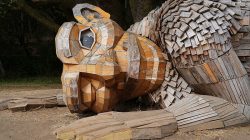Protecting a Cultural Icon: Dublin City Council’s New Initiative
Dublin City Council has announced plans to install flower beds around the base of the iconic Molly Malone statue. This initiative aims to safeguard the historic sculpture from ongoing damage caused by visitors who frequently touch and rub it. The decision comes after a trial period in May, during which stewards were stationed near the statue to discourage such behavior.
During the week-long trial, the stewards engaged with tourists and locals, politely asking them not to touch the statue. According to the council, most people were cooperative when approached. Additionally, tour guides played a significant role in encouraging their groups to respect the statue and avoid contact. However, the council acknowledges that without the presence of stewards, the problematic behavior tends to return quickly. They describe this as an ingrained part of visiting Dublin for many people.
This long-standing issue has made it challenging to change visitor habits, prompting the council to consider alternative protective measures. One such measure is the installation of flower beds around the base of the statue, creating a physical barrier to prevent direct contact.
A spokesperson for Dublin City Council stated, “It is difficult to change this behavior, so we are exploring other avenues of protection for the sculpture, including installing flower beds around the base.”
The Legacy of Molly Malone
The Molly Malone statue, which depicts the legendary fishmonger and singer immortalized in Dublin’s folklore, has been a popular tourist attraction since its unveiling in 1988. Over the years, the bronze surface of the statue has suffered damage due to repeated touching and groping, particularly of the statue’s breasts. This practice arose from a misguided tradition believed by some visitors to bring good luck.
A recent conservator’s review revealed that the statue’s patination—the protective coating on the bronze—has been worn and damaged by repeated touching and rubbing. The council is currently organizing the restoration of the statue to repair the damage and preserve it for future generations.
Ray Yeates, the council’s Arts Officer, previously expressed concern over the treatment of the statue, stating that it had caused “disquiet and upset.” The decision to trial stewards and now install flower beds follows a campaign led by singer-songwriter Tilly Cripwell called Leave Molly mAlone. This campaign aimed to raise awareness about the need for greater respect and care for the statue.
A Call for Respect and Dignity
The Leave Molly mAlone campaign highlighted how the statue has been subjected to inappropriate behavior, urging both Dubliners and visitors to treat the landmark with dignity. Tilly Cripwell welcomed the council’s actions, calling it “a wonderful victory for Dublin’s heritage.”
“I’m thrilled that Dublin City Council has taken action,” she said. “Molly Malone deserves to be admired and respected. I hope visitors will continue to appreciate her in a way that preserves her legacy and sets good social examples for future generations.”
Historical Background
The statue originally stood on Grafton Street before being moved to Suffolk Street in 2014 during Luas construction works. Its relocation was necessary to accommodate the expansion of the tram system, but it did not diminish its status as a beloved cultural icon.
As the city continues to balance tourism with preservation, the new measures reflect a growing commitment to protecting historical landmarks. By introducing flower beds and engaging the public through campaigns like Leave Molly mAlone, Dublin City Council is taking meaningful steps to ensure that Molly Malone remains a symbol of pride and respect for generations to come.







